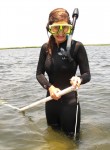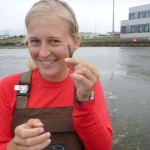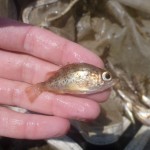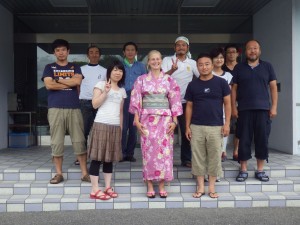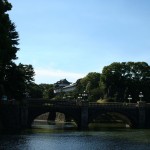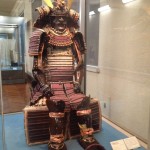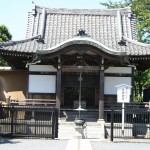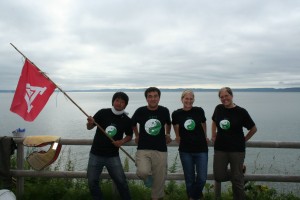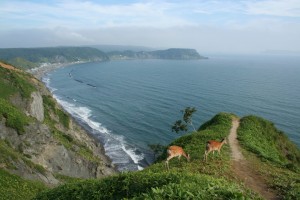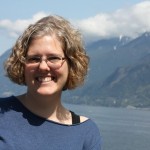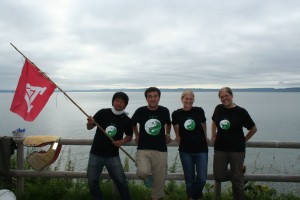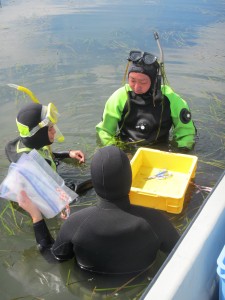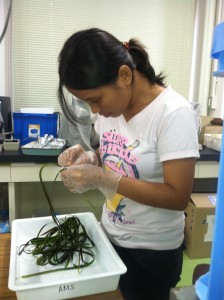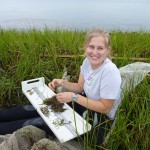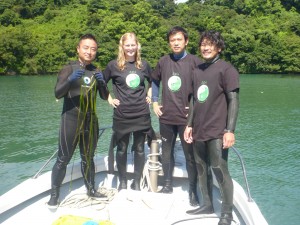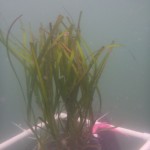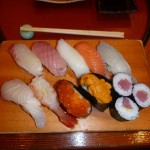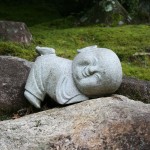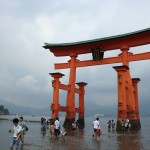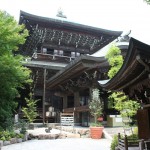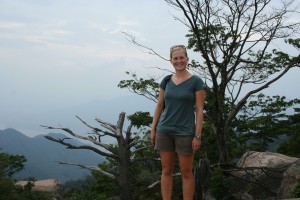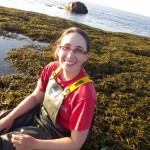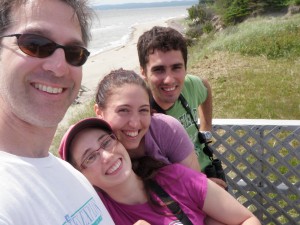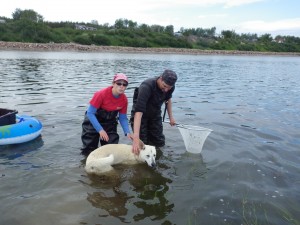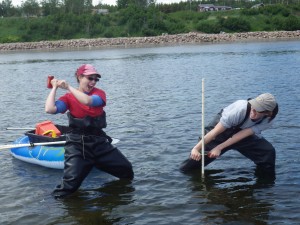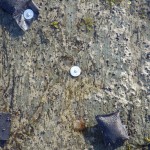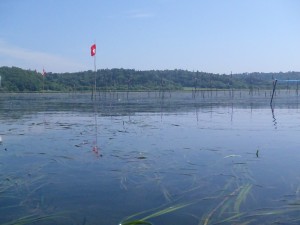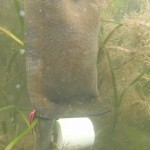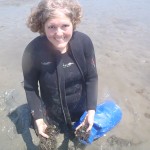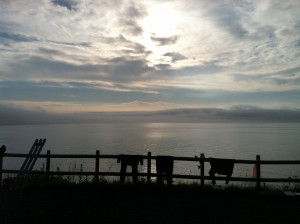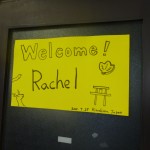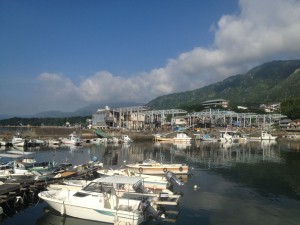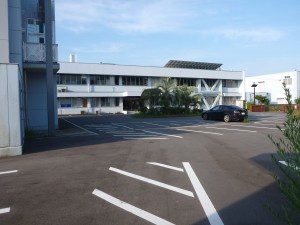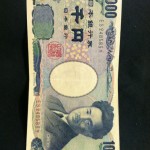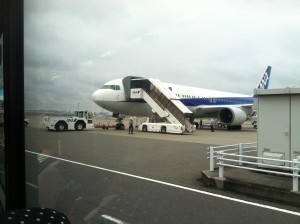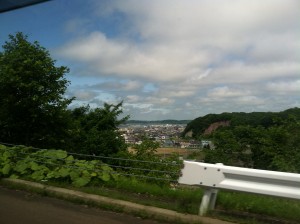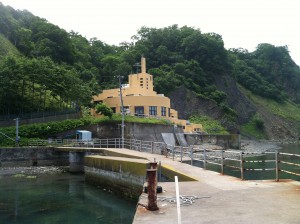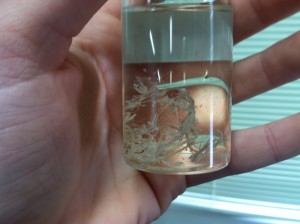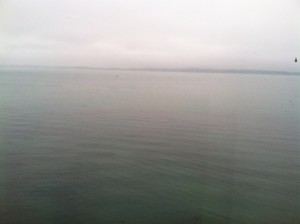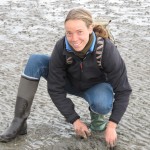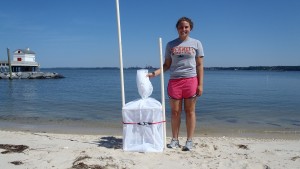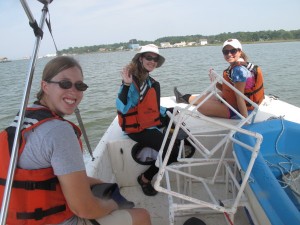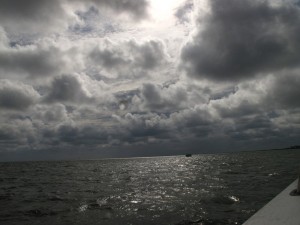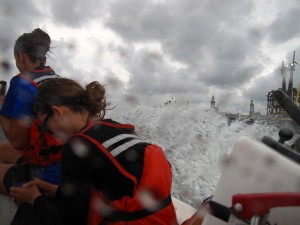Thankful for my day job
by Pamela Reynolds, ZEN Coordinator
This past week in the States we celebrated the Thanksgiving Holiday, which encouraged me reflect on all that I am thankful for – family, friends, and great colleagues near and far!
Continuing along the theme of creative collaborators, a film recently sent to me from grad student Ross Whippo in ZEN partner Dr. Mary O’Connor’s lab at the University of British Columbia in Vancouver, Canada, reminds me what a great career I have as a marine ecologist. What does your lab do?
Sayonara Hiroshima, Konnichiwa Akkeshi
by Rachel Gittman (ZEN graduate fellow)
After nearly a month in Hiroshima, it was almost time for me to make my way to Akkeshi to help Dr. Nakaoka and Nicole Kollars, the other ZEN graduate fellow in Japan, process samples post-breakdown of the ZEN main experiment. The experiment tests the interacting effects of mesograzers and nutrients on seagrass ecosystem function through the use of a grazer deterrent rather than traditional caging techniques. Before I left Hiroshima we had one more experiment to run testing the roles of predators in local eelgrass beds, and then I was off to Tokyo for a few days with Hori-san.
Conducting assays to test the strength of predation by small fishes and crustaceans on mesograzers at our field site was a fairly straightforward process, but was particularly challenging when the tide was up and the current strong. We experienced both of these conditions during our last predation assay. The water was too deep for setting up the assay by snorkel, so Hori-san and Hamaoka-san completed the assay with SCUBA. Shimbukoro-san and I used snorkels to set and collect minnow traps, which provide data on the abundance and composition of the ambient predator community. We caught several small fish in each of the minnow traps, primarily gobies and rockfish, but we decided to conduct additional fish sampling using a modified seine to get a better representation of the fish diversity at this site.
On my last day in Hiroshima, the lab surprised me with a Yukata, a summer time kimono and a farewell dinner. The next morning as Dr. Hori and I headed to the airport, I grappled with the realization that my time in Hiroshima was ending. This was not an experience I was likely to forget, but I knew that I would genuinely miss my new friends.
Finding my way in Tokyo
Before heading to Akkeshi to help Dr. Nakaoka with the ZEN experiment’s at the northern Japan site, I spent a few days in Tokyo. Tokyo is overwhelming to say the least; just stepping off the train into Tokyo Station makes you realize how large and bustling of a city it really is. You could spend an entire day just in the train station with all of the shops and restaurants, but fortunately I had time to make it out of the station and see two of the major tourist attractions in Tokyo: the Imperial Palace and Ueno Park.
Although you can only enter the palace two times of the year (new Year’s day and the Emperor’s birthday) without a scheduled tour, just seeing the outside of the palace was worth the walk in the hot August sun. Ueno Park is a large park in central Tokyo that includes numerous museums, temples, shrines, and a zoo. Although I didn’t have time to see it all, I enjoyed the exhibits in the Tokyo National Museum and visiting the shrines and temples throughout the park.
Akkeshi: a different climate
From Tokyo I headed north to the town of Akkeshi where I would spend the next week assisting with the ZEN research. Compared to the fast pace of Tokyo, Akkeshi is like a different world. Akkeshi is a small, quiet fishing town on the Pacific coast of Hokkaido, the northernmost island of Japan. The marine lab where the northern Japan ZEN team was based is located just outside of Akkeshi, within a National Park.

ZEN graduate student exchange fellows Nicole Kollars and Rachel Gittman marvel at how tall the eelgrass is in Japan
After a warm welcome from Dr. Nakaoka, his wife, the lab and a minor earthquake (although it didn’t feel so minor to me), I jumped into sample processing. The fieldwork for the main experiment (see Nicole’s blog) was complete, but we had a lot of samples to process in a very short time. Although I had processed samples for ZEN in North Carolina before, sample processing in Akkeshi was a little different. Simply put, everything is just bigger in Akkeshi. The seagrass is bigger, the grazers are bigger, and, naturally, the epiphytes are bigger. Filtering the epibionta scraped from the eelgrass shoots was a challenge because of the large scale of all of the organisms.
Fortunately, because of the dedication of the lab, we were able to complete sample processing in the week that I was there and I still had time to hike to the top of the cape above the lab with Nicole and witness to breathtaking sunsets. We also made sure to sample some of the delicious ice cream made fresh from a local dairy just outside of town.
Before I knew it, it was time to leave Akkeshi, but not before we spent our last night eating sushi and celebrating with the lab at a wonderful local restaurant. Although my trip was not quite over, this was my last day working with the ZEN team in northern Japan. I truly enjoyed the experience and learned a great deal from our Japanese collaborators. Hands-on experience conducting multiple field experiments in entirely different environments (North Carolina, Hiroshima, and Akkeshi) was eye-opening for me and gave me a new perspective on collaborative research. I have tremendous respect for the ZEN partners all over the world trying to make this project a success in their own unique environments.
I’ll end the blog here, but see my and Nicole’s final joint-blog for the highlights from our travels in the land of the rising sun.
Meditating on ZEN
by Nicole Kollars (ZEN graduate research fellow)
As my time with the ZEN team in Japan draws to a close, I am beginning to look back at what I have gained from this experience. Aside from being exposed to the dynamics of a temperate eelgrass ecosystem, I learned the ins-and-outs of subtidal field work. I collected samples for my own master’s thesis research and discovered new techniques that will be helpful for future projects. I experienced the daily life of someone who lives on the other side of the world and have mastered the use of chopsticks and the art of cooking rice. I met amazing people, saw amazing places.
All of this is wonderful, but what I am most grateful for is the experience of international collaborative science. It is really awesome to be a part of a project that brings together researchers from different countries, different cultural backgrounds, different life experiences, and different languages. Understanding the effects of nutrients, grazers and predators on the ecology of eelgrass beds provides the mission, but I think it is the universal characteristics of being a scientist (curiosity, passion, and hard work) that truly unites us. It has been an honor JN team!
ZEN – a truly international effort
by Nicole Kollars (ZEN graduate research fellow)
“Many hands make light work.”
I like this quote from John Heywood. With the breakdown for the main ZEN experiment in Akkeshi quickly approaching, I became nervous that with only four pairs of field hands we would not be able to accomplish all of the necessary sampling in a timely manner. When I helped break down the ZEN site in North Carolina early this summer we had a small army of seven collecting field samples, removing the experimental materials, and processing the samples. And in North Carolina we were all native English speakers, which streamlined field communication. But, during my time working with the ZEN team in northern Japan I have been constantly reminded that even just a few well-coordinated hands can make a massive amount of work manageable. The breakdown was no exception.
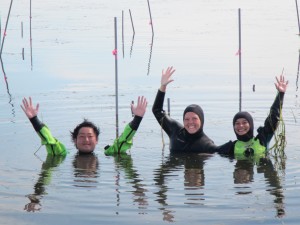
Kyosuke, Nicole, and Dr. Khwan Whankpetch during the breakdown of the ZEN experiment in Akkeshi, Japan
With 3 people in the water and 1 person on the boat handing out supplies and organizing the samples, we managed to break down the site in a smooth and efficient manner. Despite our relative lack of numbers, we managed to complete the experimental breakdown with its numerous sample collections in just two trips to the field site. I was amazed by this – not because we completed the work, but because we came to the field from four different countries. A Japanese (graduate student Kyosuke Momota), an American (me!), a Thai (visiting scientist. Dr. Khwan Whankpetch from Kasetsat University, Thailand) and a Filipino (visiting prospective student Venus Leopardas) all united together under the common mission of the Zostera Experimental Network – to produce great science.
The language barrier certainly posed a stumbling block in communicating with one another. This was especially challenging when difficulties arose and we had to work together to come up with a solution or when we were trying to find the best way to divide the work. It is a humbling experience for me because even though I am the foreigner to this country, communication is catered to my native tongue and we speak to each other in English. I wish I could say that I have learned more Japanese during my time here. I’ve mastered niceties such as “good morning” (ohayou gozaimasu) and “thank you” (arigato gozaimasu), but a full conversation is not possible – yet.
I continue to be astonished by how many languages the people I have met here not only understand but speak and read. For example, not only does Khwan speak Thai but she is also fluent in Japanese and English. Then there is the matter of the Japanese characters. In addition to learning the English alphabet, Japanese children learn three different sets of characters: hiragana, katakana, and kanji – there are over ONE THOUSAND characters in total! I have only mastered one – the “on” button for the washing machine.
Communicating in the field
Despite the language difficulties, we have learned to anticipate what one another needs and to find creative ways to express ourselves. By choosing our words carefully and speaking clearly we can usually get our point across. However, it is not to be underestimated how much you can say without saying anything at all. Through my experiences here in northern Japan I have come to realize how important thoughtful gestures and facial expressions are in average day to day communication. A smile definitely goes a long way! I have also found the ZEN experimental manual composed by Drs. Reynolds and Duffy to be invaluable. We use it both as a reference for the experimental procedures and as a tool for pointing out questions and providing answers. The methods videos accompanying the manual are also great as they show techniques that can be hard to explain even when everyone speaks the same language.
With all of the samples collected from the field, our attention turns back to the lab where the sample processing has begun. Kyosuke and I have been grateful for the help of Khwan and visiting researcher Ms. Venus Leopardas (Mindango State University at Naawan in the Phillipines). We are sad to see them leave as they return to their home countries, but we are happy to welcome ZEN student exchange fellow Rachel Gittman and undergraduate intern Ms. Minako Ito (Hokkaido University) to the Northern Japan team as we finish processing this week. It is great to be reunited with Rachel after working with her at the ZEN site in North Carolina. Stay turned for our upcoming co-authored blog entry “North and South unite!” There we will highlight our last week here in Akkeshi and our experiences as we travel across Japan before returning home. It’s incredible to think that our 6-week adventure is almost at an end!
Science and Site Seeing in Hiroshima
by Rachel Gittman (ZEN graduate student fellow)
Even though I have only been in Japan for three weeks, I am really beginning to feel a sense of home here. I have experienced so much since my last blog, but the most rewarding experience has been becoming part of the marine lab here in Hiroshima. Hori-san, Hamaoka-san, and Shimabukuro-san as well as the other members of the lab have made me feel both welcome and comfortable. We have lunch and afternoon tea together each day and although I am still struggling to communicate at times (I wish I could say my Japanese is improving, but I haven’t really gotten past basic greetings and responses), I am learning so much.
We have been very busy over the last few weeks with two ZEN experiments – a short term assay to examine the intensity of predation on mesograzers and a longer experiment to examine predator effects on the seagrass community. Thanks to the hard work and dedication of the lab, all of the experiments have been running smoothly thus far. After a week of cage building, we were ready to set up the longer predator exclusion experiment. Setting up the experiment here is a little different than setting it up in Virginia or North Carolina because our site is entirely subtidal and it gets pretty deep when the tide rises.
Hori-san and Shimbukoro-san used SCUBA to set the cages, while Hamaoka-san and I snorkeled above them, holding our cages on a long rope leash. The entire set-up took about six hours and I was able to capture about half of the set-up in a timelapse from shore.
Although we have been busy with our field experiments, the lab was kind enough to take me out for my birthday and gave me a great birthday present: cake and my own house shoes (very important to have in Japan). It was a wonderful birthday surprise and I am glad I was able to spend my birthday in Japan.
I share my birthday (August 6th) with the anniversary of the a very tragic day in history, the detonation of Little Boy, the first atomic bomb used in World War II. I was able to visit the Atomic Bomb dome, the remnants of the government building that was almost directly below where the detonation occurred, and the Peace Memorial Park. Visiting those sites was a humbling but positive experience because of ongoing efforts by the Japanese people to encourage world peace.
Beyond just seeing the sites, visiting Japan has also been about the experiences and more importantly the food! After much anticipation on my part as an avid sushi-lover, my hosts took me to a Japanese sushi restaurant in Hiroshima City. I could hardly contain my excitement as we sat down to order at the sushi counter. We had a perfect view of the chefs preparing the sushi and I was determined to try everything. Needless to say, I was not disappointed. The sushi was amazing and included some items that were new to me, such as squid, octopus, and urchin. The atmosphere, food, and my new friends made the night one that I am not likely to forget.
I can’t end the blog without sharing a few more of my site seeing adventures.
Over the weekend and this past week, I had the opportunity to visit some of most beautiful and historic places in this part of Japan: Miyajima and the Iwakuni Kintai bridge, in addition to the peace and atomic bomb memorials in Hiroshima City. Miyajima is a World Heritage Site just a few kilometers and a short train and ferry ride from the FRA Institute. The island contains many historic sites, including the Otorii Gate, Itsukushima Shrine, and Daishoin Temple, as well as nature trails that lead to the top of Mt. Misen.
After exploring the temples, shrines, and the public aquarium I decided to hike to the top of Mt. Misen to get a good view of the area. Along the way, I happened to meet a fellow North Carolinian, and we decided to hike up together. It was a good choice, because the 3km hike was very steep and the humidity and heat made reaching the top quite an accomplishment. The view was worth it though and the descent was much more pleasant.
I want to save some of my site seeing for another blog post, but I will briefly mention the Iwakuni Kintai bridge. Built in the early 1600s, it was deemed “indestructible” because of the superior engineering design and construction, well ahead of its time. The bridge is not only impressive from an engineering perspective, it is also incredibly beautiful. Although the bridge was partially destroyed in the early 20th century, it was restored to its original glory a few decades later and it still maintained in its original design and structure. Seeing the bridge just as the sun set was worth the wait. Having to wait for it to get dark also meant I could get more ice cream – this time I went for mango. I am pretty sure I have eaten more ice cream here in the past three weeks than I have for all of last year. What can I say except that it is just delicious!
Interest in the ‘ecological organism’ leads student to pursue “wet” science
by Stephanie Cimon (graduate student at the ZEN site in Quebec, Canada)
My name is Stephanie. I was born 25 years ago in Saint-Nicéphore (Québec, Canada). I am a Master’s student at the Université du Québec à Chicoutimi. Even two years ago, I had no idea I wanted to become a marine biologist. I always wanted to work with living things, from big animals to tiny cells. When it was time to choose a university program, I was captivated by how the human body works. So, I did my bachelor’s in biomedical sciences in Montreal. I was really interested in this subject, but while finishing my degree I realized that I wanted to spend time outside and so I started to take ecology courses. I think an ecosystem works a little bit like an organism. My curiosity in how the human body works was replaced by a interest in how entire ecosystems work. I then started another bachelor’s degree in biology at Chicoutimi and realized that I wanted to work with something related to water. I’ve always loved the water and especially the seaside.
In the winter of 2011, we had to choose a project for a course called “Introduction to Research”. I visited Dr. Mathieu Cusson who introduced me to the ZEN project. I knew I wanted to be part of it. Last summer I was hired to work in the intertidal zone of the St-Lawrence Estuary for the ZEN experiment and for three other projects. I spent all summer moving from one place to another and I really enjoyed it. Mathieu was really busy, and so I had to organize the planning of our ZEN experiment and prepare for the fieldwork and laboratory processing at our site. Thank to Drs. Cusson, Duffy and Reynolds, everything went well and I appreciated the experience I acquired doing it.
Our site is situated in Pointe-Lebel (N 49°06’, W 68°10’). The water there is quite cold at 13°C (55°F). There are some “holes” in the intertidal due to scouring action by ice. The holes can be more than 30 cm deeper than the surrounding area. We didn’t have wetsuits and instead used waders, so we had to watch our steps so we wouldn’t fall into one of those holes. The third day we were there to start the experiment, one of our team took the unwanted plunge. Fortunately that day, the tide was so low that the water was “hot” at 20°C (68°F). A few times, some of us made the mistake of bending a little bit too much while working in the water and flooded the waders with the icy seawater. I did it once, and by the end of that day the only part of my body that was not wet was my head. It’s a bit of a game to see who can stay the driest, or manages to get the wettest! Fieldwork is always good entertainment.
To carry the experimental materials out to our field site, we used beach boats, but every once and a while something would fall into the water. For example, somehow Mathieu’s backpack slid off the boat and onto the water where it rolled for few seconds before I grabbed it. When working in the field anything valuable needs to be kept in water tight bags to be safe.
This year, we are still participating in ZEN, but because we do not have enough time and labor, we were only able to participate in one of the projects involving assessing the intensity of predation of small crabs, shrimp and fish on small invertebrate grazers at our site. Our first visit to the site in June was a complete fiasco! We had such bad weather that we lost all of the experimental materials. First, a storm took our five minnow traps. We didn’t want to believe it, so we searched an hour. We kept up hope because the visibility in the water wasn’t good. After recovering two of the five bricks used to attach the traps, we had to face the truth. The ropes did not make it. We also lost 88 podsicles (a special little pole where a food item is glued) out of the 96 we deployed. We were luckier on our next visit last week. We had beautiful sun and hot weather. We recovered everything. We felt like it was a holiday!
I am now starting the fieldwork for my master’s degree studying the rocky shore of the St-Lawrence Estuary. My project is about the resilience (ability of a system to recover quickly) of the local benthic community. We removed everything living in 50×50 cm quadrats and burned the rock to be sure all we had left was bare rock. I want to examine the succession (development over time) of the algae and whether different perturbations such as grazing, nutrient enrichment, or thermal stress (through the removal of canopy forming fucales algae) can influence the ability of the community to recover. I think the algae will grow faster with nutrient enrichment, and that the grazer removals will cause slower recovery to pre-experimental conditions as grazing may be important for algal succession. I expect that thermal stress by canopy removal will make the return to normal difficult. I am excited to see if there are some differences. For now, there is still almost nothing on the rock, but I expect to soon see some mussels and algae begin colonizing the area.
Marine ecology is a stimulating profession I am pleased to discover day after day. I am glad to participate to the ZEN project for the second year and I am looking forward to see the results. It helped me choose my path as a biologist. Thank you ZEN!
First week in Akkeshi, Japan
by Nicole Kollars (ZEN graduate student fellow in Northen Japan)
I do not think my wetsuit had a chance to fully dry out this week as we were in the water at the ZEN field site everyday. With several experimental pushes (setting up an experiment to measure predator impacts on mesograzers, maintaining the main ZEN experiment, and surveys of the ambient predator community) it was a busy week for eelgrass science in northern Japan!
Science by canoe
A team of four made maintaining the ZEN experimental plots a smooth and efficient process. We used a canoe to keep bags of plaster blocks, extra cable-ties, and spare scissors easily accessible. While one person paddled around the plots and handed out supplies, the rest of us used mask and snorkel to change the old blocks out for the new. Luckily, the tide was at a good height to make snorkeling easy but the ever-present jellies still makes working at this site quite challenging!
Learning how to catch a fish
Before traveling to Japan I had never appreciated how creatively scientists can modify their use of the same or similar experimental gear to overcome obstacles posed by working under diverse field conditions. I’ve surveyed small aquatic predators before using a seine net (a large net attached to two poles dragged through the seagrass to capture fish and other predators). But, I had never seen one used quite like they do at the ZEN site in Akkeshi. We used a typical seine design (floats on top, weighted on the bottom), but with the addition of a tow net attached to one side of the seine. In the water, the seine net was walked out until completely stretched in one direction. Then we walked the ends of the net toward each other to form an enclosed circle. Moving very slowly, we gradually decreased the circle in size until all the fish were forced into the tow net. The tow net could then be emptied into a bucket and the fish counted, measured, and released. It was an effective design that did not require spending time picking the fish out of the netting of a traditional seine. I think this purse seining technique is similar to techniques that shrimpers and other commercial fishermen use to capture fish in the open ocean, but it’s not something I’d ever seen before. But that’s part of why I’m in Japan – to learn new techniques and do rigorous science at the same time.
A surprise trip to a tidal flat
To my absolute delight, after finishing work at the ZEN site one morning we swung by a tidal flat where I could collect samples of the local Gracilaria seaweed for my thesis research. While this species is introduced and invasive in the Southeastern USA, it is native to mudflats here in Akkeshi. The shallow water prevented the boat from getting too close to the shore, so we had to hike over one kilometer in shin-deep mud before we started seeing the seaweed. This happened to be the day when the sun shone bright and my 10 mm worth of neoprene grew unbearable as I made my way through the mud. But the end result of seeing Gracilaria in its native habitat was well worth the exertion and I was able to collect enough samples for my project and make some useful observations.
Interestingly, in the Akkeshi mudflats most of the Gracilaria is settled onto the shells of a local gastropod. This contrasts to the Southeastern USA where the decorator polychaete Diopatra attaches fragments of Gracilaria to its tube. In both cases, the seaweed is using an animal for substrate but through very different mechanisms. I also found amphipods living on Gracilaria. Similar to how the amphipods in the eelgrass beds are larger in Akkeshi than in the Carolinas, the amphipods I found on Gracilaria are gigantic compared to what I have seen in Charleston. A huge thanks goes out to Dr. Nakaoka for facilitating the endeavor, Dr. Honda and Kyosuke-san for hiking through the mud and collecting samples with me, and ZEN for bringing me to Japan!
All in a week’s work
Now at the week’s end my wetsuit finally has a chance to dry out and I look forward to a weekend of rest, a lab dinner party (with the promise of local Hokkaido seafood and good sake), and a canoeing trip up the Bekanbeushi River. “Work hard, play hard” definitely describes the life of a marine field ecologist here in Japan. Otsukaresama (thank you for your hard work) ZEN team!
First week in Hiroshima, Japan
by Rachel Gittman (ZEN graduate student fellow)
After three flights totaling approximately 17 hours, I finally arrived in Hiroshima, Japan on July 25th, 13 hours ahead and a day later than when I left Beaufort, NC.
Although I am still recovering from jet lag (5AM I am wide awake, but 3PM feels like the middle of the night), I have already begun exploring the amazing sights here in Hiroshima. I have decided to do my best to document the trip not only with blog entries, but with photos and a short documentary on the ZEN project here.
Prior to my trip to Japan, I participated in a ScienceFilm workshop led by Jeff Morales and Robert Wooten, both previous staff and current freelance documentary filmmakers for National Geographic. Graduate students at the University of North Carolina at Chapel Hill’s Institute of Marine Sciences and Duke University’s Marine Lab coordinated the workshop. Students learned how to film, edit, and produce science documentaries to help promote their research or important scientific topics. Although the course was brief (5 days), it provided an excellent crash course in filmmaking and hopefully has prepared me for making my own short film about the project here in Japan. Now if I can only remember these key tips: use a tripod, don’t zoom, and lighting matters!
Back to Hiroshima… I am working with Dr. Masakazu Hori at the National Research Institute of Fisheries and Environment of Inland Sea (FEIS), part of the Fisheries Research Agency (FRA) in Hatsukaichi, Hiroshima. Dr. Hori is the lead PI for the southern Japan site and is conducting two ZEN experiments this year: the predator assay and the predator exclusion experiment. We ran the first predation assay on Thursday and Friday of this week. The experiments are being conducted within a sheltered cove off shore of an island across from the Takehara Fisheries Research Station.
To get to the field site, we have to take a boat, which is typical for marine work, but this boat is a little different. Instead of launching the boat from a trailer or keeping it in the water, each time researchers at the station need to use the boat, it has to be lifted and lowered over the seawall into the water. It’s pretty impressive to watch and it is the perfect way to keep the boat clean!
After a 5 minute boat ride, we arrived at our site, a quiet cove filled with giant Zostera marina shoots! I was surprised at how cool the water was when I first got in since the air temperature was well into the 90s oF with high humidity. It was refreshing and although I was a bit wary of the jellyfish graduate student Matt Whalen had encountered last summer, I was soon completely engrossed in exploring the seagrass beds, or forests as I view them. The beds are extremely dense and tall, with most shoots rising more than one meter from the bottom and around 3cm wide! These beds dwarf the beds we have in North Carolina. We started an experiment measuring the effects of small crab, shrimp and fish predators, which involved some diving and snorkeling because the seagrass can grow as deep as 10m here!
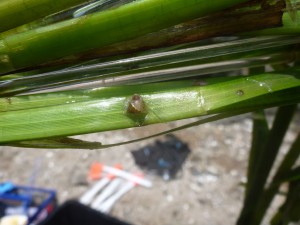 The following day we collected the experiment and found fairly high predation rates, particularly on amphipods. Although I did not spot many fish in my snorkeling adventures, clearly they were lurking in the murky depths of the beds. The visibility was poor, similar to our waters in NC, so I felt right at home.
The following day we collected the experiment and found fairly high predation rates, particularly on amphipods. Although I did not spot many fish in my snorkeling adventures, clearly they were lurking in the murky depths of the beds. The visibility was poor, similar to our waters in NC, so I felt right at home.
I am looking forward to setting up the predator exclusion experiment next week, but for now I am spending my weekend walking around and getting to know this part of Hiroshima. More to come next week…
8000 miles for science!
by Nicole Kollars (ZEN exchange fellow in Northern Japan)
Over 8000 miles is the distance I am estimating that I have travelled in the last 30+ hours from my home in Charleston, South Carolina to Akkeshi, Japan where I will be assisting Dr. Massa Nakaoka and his team with the 2012 ZEN experiment at the northern Japan site. My flight left Charleston at 1430 EST and I arrived safe and sound in Akkeshi around lunchtime… 2 days later!
With working to bring my own research in Charleston to a stopping point before heading to Japan, I did not have time to start packing until 2230 the night before my flight. Even the morning of my departure I was still making the phone calls necessary before leaving the country (banks, utility companies, Grandma) and packing right up to the last minute. Before I knew it my 40 lb backpack (which is larger than I am!) was stuffed into the backseat of my housemate’s car and we were off to the airport. On the drive there I received a call form Pamela telling me my flight to Washington DC was delayed due to weather. Upon arriving at the airport, I spent 45 minutes talking with the man at the ticket counter and learned that you should never underestimate an airline employee who knows how to work the system. First he made sure that I had a reservation on another flight in case I could not make my connecting flight to LA when I arrived in Washington D.C. Next, he had my gigantic backpack checked all the way to Kushiro (my final destination) and he had printed out my boarding passes for my ANA flights to Japan. This was amazing considering I was traveling on two different airlines.
In the end my flight to D.C. only departed 3 minutes late and actually arrived 10 minutes early. Catching my flight to LA was not going to be a problem and I even had time to find a Travelex kiosk so that I could exchange some US dollars to Japanese yen. And I must say, the Japanese banknotes are quite beautiful! With my new currency in hand, I boarded the flight to LA on time and I settled in next to a Buddhist monk heading to Burma and a young woman on her way back to Australia. We were pulling out of the gate and heading for the airstrip when the Captain announced that all flights were grounded until further notice due to severe storms over the Blue Ridge Mountains just west of D.C.. Luckily, Pamela and I anticipated potential delays when booking my flights so the nearly 2-hour standstill on the tarmac was not going to prevent me from catching the plane to Tokyo once I reached LA.
I arrived in LA a little after 2100 PST (travel time thus far: 10 hrs). The process of getting from the domestic flights terminal to the Tom Bradley International terminal (TBIT) was quite the adventure. With the chaos of LAX ground transportation (cars everywhere and incessant honking), I have to admit that when I finally walked into the arrival lobby of TBIT, I was quite overwhelmed. However, the employees at the ANA counter where I had to exchange the boarding passes I received in Charleston with the official ANA boarding passes were helpful and polite. They even gave me a head’s up about customs procedures in Tokyo which was very much appreciated.
I was half-asleep by the time I boarded the plane at 0045 PST (0345 to my US east-coast adjusted body) and I curled-up in my window seat and cannot even remember taking off. I was worried that I wouldn’t be able to sleep on the nearly 11 hr flight to Tokyo, so when I woke up 6 hrs later, I was quite relieved that I wouldn’t be arriving in Japan resembling the waking dead.
The part of the flight that I was awake for was very pleasant. The stewardesses were gracious, the seats comfortable and spacious, and the food amazing. I was anticipating the ANA provided meal ever since I read Matt Whalen’s post about his own experience travelling to Japan and I was not disappointed. There was just enough time to re-read the 2012 ZEN manual for a quick refresher of the science that awaited me in Akkeshi before the plane began its descent into the land of Nihon.
I arrived at the Tokyo Haneda airport a little after 0400 Saturday morning – Japan time (travel time thus far: 25 hrs). My first impression of the airport was that it was incredibly clean, sleek, quiet, and peaceful. I was grateful for this because I was expecting a people-filled, noisy environment of chaos, similar to what I left in Los Angeles. Customs was thankfully painless; I think the gentleman who inspected my bag was amused by the piles of neoprene that I had packed anticipating the cold water of the ZEN field site in Akkeshi. If it wasn’t already obvious that I was a foreigner, I think the slow walking pace and my wide-eyed look would have given me away in an instant as I proceeded to wonder through the airport taking it all in – the signs that I didn’t understand, the new sounds and tones, and the sleek design of practically everything.
I had one more flight from Tokyo to Kushiro before my travels were over. As the plane descended into Kushiro, I was taken back by the beautiful green forests of Hokkaido. Two members of the Nakaoka lab were waiting for me at the airport – Kyosuke-san, a 2nd year master’s student at Hokkaido University, and Kentaro-san, a research fellow with Dr. Nakaoka. It was about an hour drive from Kushiro to Akkeshi through lush wetlands scattered with small farms. We passed a couple of fields of workers stretching out long pieces of the kelp Laminaria to dry. Kentaro-san explained that the algae is harvested from the ocean, but the coast is too foggy for the seaweed to dry effectively so it is transported inland to be laid out in the sun. Seeing the fields filled with these algae reminded me of the economic importance of seaweeds and how algae are used to make so many products we use in the USA and around the world everyday, from ice cream, to toothpaste, to sushi.
We arrived in Akkeshi around lunchtime (travel time thus far: 32 hrs). To reach the marine station, you have to drive through the town of Akkeshi and travel over a long red bridge that marks the separation from Lake Akkeshi (the estuary) and Akkeshi Bay (the sea). As we drove over the bridge I saw the thick eelgrass beds that dominated these waters – I can’t wait to see these plants up close and personal when we set up the ZEN experiment here next week!
After crossing the bridge, we drove down an incredibly steep and curving hill to reach Akkeshi Marine Station. Kyosuke-san saw that I was settled into the dormitory where I will be staying for the next 6 weeks and gave me a tour of the lab. When Kyosuke-san showed me the jars of the ethanol-preserved predators and grazers commonly found in the local eelgrass beds, I was shocked by how giant the caprellid amphipods and isopods are here. They definitely are not that big back home in the Carolinas!
Over 8000 miles and 30+ hours later, I am all settled into Akkeshi on the other side of the world from home. We start the ZEN experiment this next week and I really look forward to the next 6 weeks of giant amphipods and 6 ft (over 2 m) long Zostera blades. I am grateful for the opportunity to be here, the warm welcome I have received, and the adventures that lay ahead.
When I woke up from a very long nap and looked outside my dorm window to the glassy, misty ocean view, with herons flying by and the soft sound of waves lapping the shore, my first thought was how this is all very ZEN. Literally.
Fieldwork is never boring
by Serena Donadi (ZEN exchange fellow in Virginia)
One of the most exciting days in the field was when we installed cages for an experiment examining the effects of predators (shrimp, fish, crabs) on the seagrass comminity. After spending many days cutting PVC pipes, sewing meshes and gluing parts together, our cages were finally ready! The plan was to go to the experimental site (Goodwin Islands), pound 60 poles into the sediment and attach our cages to the poles with bungees and cable ties so that the currents wouldn’t drag them away. Plus, to make the cages sink to the sea bottom, we planned to put few shovels of sand inside each mesh.
The cages are basically empty cubes (sides of about 0.5m), made by PVC poles, which are enclosed in a mesh bag. Inside the cages, seagrass communities are recreated by adding mesograzers (gastropods and crustaceans such as amphipods and isopods) and seagrass shoots attached to a plastic screen. The aim of the experiment is to keep all predators (fish and crabs) outside and see what happens… Will the populations of grazers increase? How will such an increase affect the algae and seagrass? Do we see evidence for a trophic cascade, where animals at top trophic levels promote plants at lower trophic levels by controlling species at middle levels?
The weather forecast that day was not very optimistic and there was chance of thunderstorms. We decided to give it a try and started loading everything we need on the boat. The boat was literally full! I wish I’d taken a picture. After adding 10 buckets full of sand, lots of poles, coolers with seagrass and other field. I was really afraid we would sink. But our captain for the day, Kathryn, carefully directed us as to how to load the boat to balance the weight and we were safely on our way. Once we arrived at the field site, the bad weather started rumbling and dark clouds were quickly moving in our direction. I have been in Virginia for more than one month now, but I am still surprised by how fast thunderstorms can appear here and how strong they can be. We decided to quickly head towards a sheltered dock nearby and wait for the storm to pass. After one hour we were back in the field.
It’s odd to say after so many days of terrible heat, but the water was chilly! I was glad I had my wetsuit with me. The sea was still quite rough making the fieldwork quite challenging. To be able to attach the cages to the sea bottom, I wore an incredible heavy weight belt. Despite it, the drift of the waves could still make me roll on the bottom as I snorkeled. The water was so murky that I was not able to see what my hands were doing. Sink to the bottom, stretch my legs to avoid rolling, bind the bungee around the cages and secure everything with cable ties.
After a few hours all of us were trembling because of the cold, the tide was rising, and dark clouds began to cover the sky. Finally the last cage was placed and we jumped on the boat. The sea was stormy and Captain Kathryn did an awesome job in bringing us back to the VIMS boat basin where we store the boats. On our way, heavy rain poured from the sky, hurting on our skin and blinding our eyes. I put on my diving mask and thought how ridiculous I should look wearing a mask and a wetsuit outside of the water. Eventually we arrived at the boat basin, tired, hungry and cold.
That night as I lay in my bed and thought about the day, I realized how lucky I am for having this great chance to work with wonderful people in this amazing ecosystem. It was so much fun! Really, it was one of my favorite days so far in Virginia.

